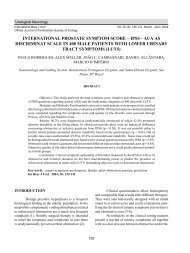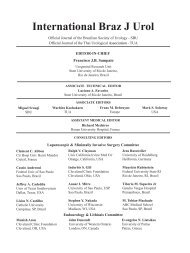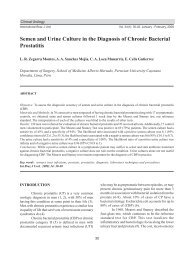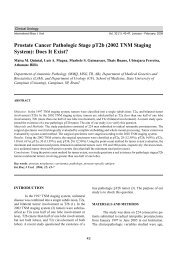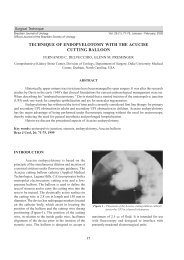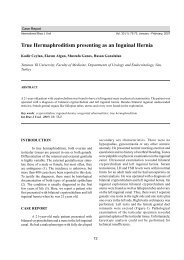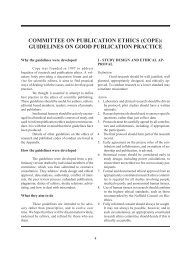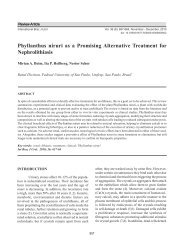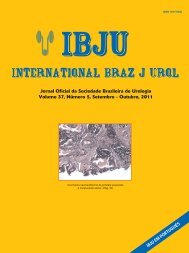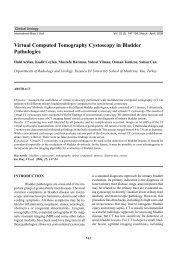UROLOGY - International Braz J Urol
UROLOGY - International Braz J Urol
UROLOGY - International Braz J Urol
Create successful ePaper yourself
Turn your PDF publications into a flip-book with our unique Google optimized e-Paper software.
BRAZILIAN JOURNAL OF<br />
<strong>UROLOGY</strong><br />
EDITOR’S COMMENT<br />
The September - October 2000 issue of the <strong>Braz</strong>ilian Journal of <strong>Urol</strong>ogy presents outstanding<br />
contributions from USA, Europe, and <strong>Braz</strong>il.<br />
Doctors Rassweiller from Heilbron and Eisenberger from Stuttgart, Germany, present on<br />
page 463 a critical analysis on management of staghorn calculi after 250 cases. A total of 197<br />
patients were treated with the new technologies in a five-year period and compared to 83 patients<br />
who underwent open surgery for complicated nephrolithiasis prior to the introduction of ESWL<br />
and endourology. The introduction of minimally invasive techniques has completely changed<br />
the management of complex stones. However, the multimodal minimally invasive therapy of<br />
complex renal stones requires an individual treatment plan for each patient depending on stone<br />
burden and distribution, anatomy of the collecting system, and the composition of the calculus.<br />
Doctor Preminger from North Caroline, USA, one of the most recognized world experts on stone<br />
disease, provided an Editorial Comment on this article.<br />
Doctor Tiselius from Karolinska Institute, Stockholm, Sweden, authored on page 452 a<br />
comprehensive up-to-date presentation on stone incidence and prevention. The average lifetime risk<br />
of stone formation has been reported to be in the range of 5-10% with a considerable geographical<br />
variation. In Europe it was estimated that stones form in 2,000 persons of a population of one million.<br />
Of these patients, 500 (25%) will require active stone removal. It was also showed that as many as<br />
75% of the patients suffers the risk of repeated stone formation during a follow-up period of 20<br />
years. The recurrent nature of stone disease makes it important not only to remove stones from the<br />
urinary tract and to assist in the spontaneous passage of stones, but also to offer these patients an<br />
appropriate metabolic care.<br />
Doctor Lancina and co-workers from La Coruña, Spain, performed a comprehensive metabolic<br />
evaluation on 106 single calcium stone formers, and on 394 recurrent calcium stone formers (170<br />
mild and 224 severe forms of the disease), page 479. The authors found that recurrent stone formers<br />
present more frequently hypercalciuria and alkaline urine, and also excrete in urine more calcium<br />
than first-time stone formers. Recurrent stone formers had first stone occurrence younger than single<br />
stone formers. The authors concluded that calcium stone formers with high level of calcium in urine<br />
or with alkaline urine pH are associated with a high recurrence rate and require constant clinic<br />
watchfulness with selective medical therapy for preventing new stone formation.<br />
On page 488, Doctor Böhle from Medical University of Luebeck, Germany, one of the world<br />
leading researchers on Bacillus Calmette-Guérin (BCG) in superficial bladder carcinoma, presents<br />
the most recent knowledge on this form of immunotherapy. Although the BCG’s mode of action has<br />
not been fully elucidated yet, the author provided a conclusive overview on this complex field and<br />
gave detailed information on several aspects of relevance for the understanding of the involved<br />
immune mechanisms.<br />
450
EDITOR’S COMMENT - continued<br />
Doctor Alvarez-Alvarez and colleagues from Vigo, Spain, reported on page 503, their<br />
experience on prostate needle biopsy specimens that contained foci of atypical small acinar<br />
proliferation (ASAP) but not diagnosed for malignancy. Among 1,345 prostate needle biopsies, 39<br />
cases (2.89%) showed foci of ASAP. Of these, 10 (52.63%) were later found to have adenocarcinoma,<br />
with a mean Gleason score of 6.28. Forty-two percent of cases with uncertain diagnosis and 63.6%<br />
from the probably malignant group were carcinomas. The authors concluded that the recommended<br />
clinical attitude after a diagnosis of ASAP must be careful patient follow-up considering the repetition of<br />
biopsy after few months. Doctor Bostwick, from Virginia, USA, one of the world experts on prostate<br />
pathology, provided an important Editorial Comment on this article.<br />
On page 510 Doctor Luján and co-workers from Madrid, Spain, reported the Spanish<br />
contribution to the European Randomized Study of Screening for Prostate Cancer (ERSPC). At a<br />
Spanish center, 2,416 men were included in the screening arm, and 264 biopsies were performed.<br />
The authors performed biopsies when PSA ≥ 3.0 ng/ml (rectal examination is not considered to<br />
indicate biopsies in these cases). Fifty-four prostate cancers were detected (47 localized, 5 locally<br />
advanced, and 2 metastatic); overall, detection rate was 2.24%. The authors suggested that screening<br />
detects more cancers at an early stage. Nevertheless, it is necessary to wait at least for 10 years of<br />
follow up to verify if a significant benefit, with regard to prostate cancer mortality reduction, is<br />
achieved.<br />
Doctor Martins and colleagues, from Ribeirão Preto, <strong>Braz</strong>il, studied on page 516 the<br />
incidence of carcinoma of the prostate in 1,079 volunteers from a community population. Two<br />
hundred and thirty-five volunteers with PSA greater than 4.0 ng/ml, positive digital examination<br />
or both were referred to prostate biopsy. Of the 136 (57.6%) men who agreed with the biopsy, 27<br />
(2.5%) had tumor and 10 (0.9%) had isolated prostatic intraepithelial neoplasia (PIN). Thirteen of<br />
the cancer patients were submitted to radical prostatectomy, which revealed that 61.5% of them<br />
had tumor stage lower than pT3.<br />
On page 535 Doctor Telöken and co-workers from Porto Alegre, <strong>Braz</strong>il, demonstrated that a<br />
period of 10 weeks of hypercholesterolemic diet induced increase in the thickness of rabbit penile<br />
tunica albuginea and an increase in the blood levels of cholesterol and testosterona.<br />
Dr. Francisco J.B. Sampaio<br />
Editor-in-Chief<br />
451



